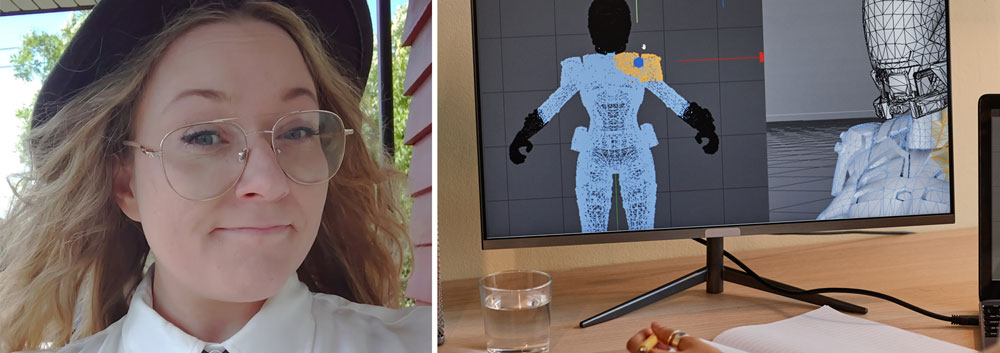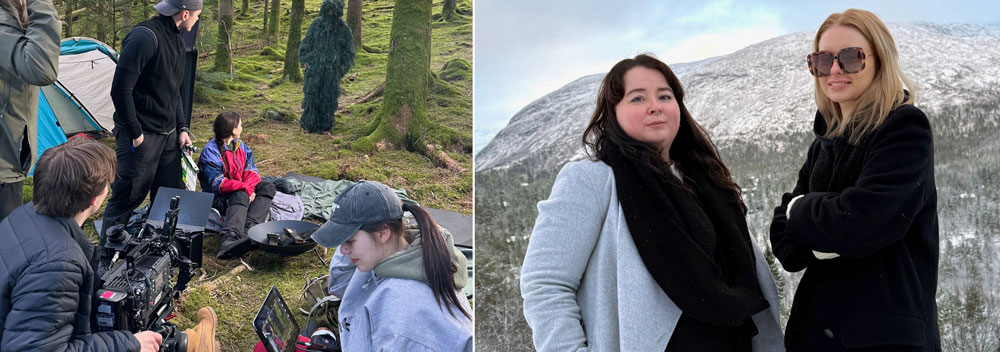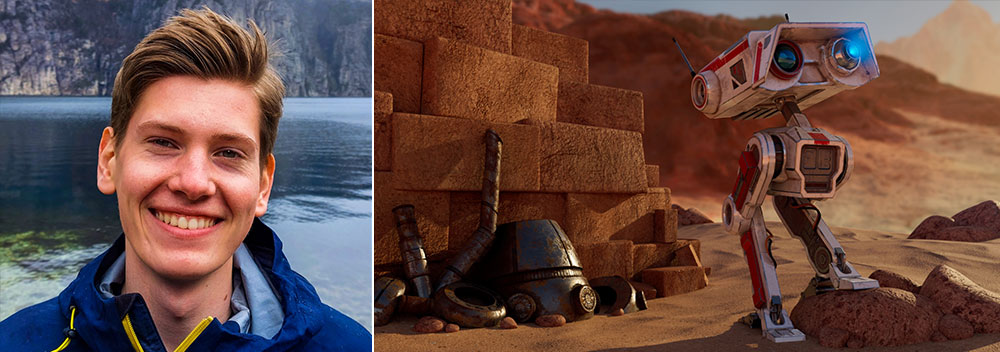Vocational School 2 years Online Studies
Learn to produce animated 3D films, environments and characters from idea to finished movie. This education prepares you to work with 3D content for movies, web, advertising, marketing and virtual reality.
Apply now
The first year of the 3D Film Production program is identical to 3D Design and Animation. However, you can apply directly for this two-year 3D film production program.
3D digital films are created in a totally different way to normal film. During this course, you will create a short animated film, according to your own framework. You will need to calculate budget costs, plan and organize the process and implement all of this.
Film technique and pre-production
You need to create a story before creating a film. The next step is to create a storyboard, where the scenes are drawn with descriptions of movements and the mood. You then animate pre-visualisations of the film before beginning the process of creating the final film.
Our teachers are very engaged and help you with everything you need. You learn many things needed to find a job later on.Tine Karlsen
A film creator uses tools to manipulate the public to experience a story in the way they intend. You can use camera movements, camera angles, cutting, sound, lights, shadows and colors to create moods and undertones.
The course gives you a deep insight into software needed to create convincing 3D productions. To ensure good skills in the use of 3D-software, all of our students have access to the world’s largest net based video course portal.
Digital dramas
In 3D films, the animator takes the roll of an actor. It is your job to bring 3D characters to life in a realistic way. If you have seen an animated film that made you laugh or cry, felt afraid or happy, this is due to the animator’s achievements. In order to convey moods and undertones, the animator needs knowledge of anatomy, body language, subtitles and drama.
It is crucial that the lip movements and sound are synchronized when the characters talk. You therefore need to use knowledge of phonetic and language sounds to create the right lip movements for your character.
Program Structure
After completing the course, you should be able to plan and produce realistic 3D animated films, create and animate figures and objects and create systems to animate them. After animating a character, lighting will be added to the environment in order to create a specific atmosphere.
You should be able to work purposefully according to methods used in the industry. You will understand the importance of being solution orientated and flexible, as well as having had experience in adapting to unexpected changes during production.
By the end of the course, you will have animated your own film which can be added to your portfolio and included on your CV.
Courses covered during the first year - identical to 3D design and animation:
- Modeling, texturing and light 1
- Modeling, texture and light 2
- Modeling, texture and light 3
- Modeling, texturing and light 4
- Visual effects
- Concepts 1
- Portfolio 1
- Animation
- Character animation 1
- Character building
- 3D character design
- Character animation 2
- Student project
- Portfolio 2
- Portfolio 3
Courses covered in the second year:
- Concept drawing
- Digital plays
- Creative storytelling
- Film technology and previsualization
- Pre-production
- Animated film project
Year 1 - identical to the 3D design and animation program
- a broad knowledge of the concepts and processes used in modeling, texturing and rendering
- knowledge of the twelve animation principles
- indepth knowledge of 3D tools used in 3D design and animation
- insight into relevant and standardized working methods in terms of planning, preparation and completion of various tasks in 3D graphics
- insight into the regulations for incorporation, use and publication of materials from a third party manufacturer
- industry knowledge about the 3D industry and knowledge of the professional field
- update your vocational knowledge in 3D design and animation
- understand 3D industry's importance in a social and value creation perspective
- apply professional knowledge in analysing a client’s brief and create a plan for implementing the production of the product
- apply scientific knowledge to recreate illustrations or real objects virtually through modeling, texturing, lighting and rendering in a 3D program
- apply relevant tools to character and object animation so that they move in a believable way
- find information and content that is relevant for the area of 3D and animation by having knowledge of the industry and using other resources such as literature and online forums
- identify a situation and professional challenges in all phases of a 3D production, devise and implement practical solutions
- understand occupational and industry ethical principles to credit third parties and check the legality of using third-party tools in a concrete production
- develop an ethical attitude in the exercise of the profession and understanding of the importance of keeping appointments, deadlines and budgets
- carry out a task after identifying a target group’s needs in the area of 3D design and animation
- build relationships and network with colleagues and other stakeholders in neighboring creative disciplines in order to solve more comprehensive projects
- develop working methods based on a comprehensive understanding of the work process and the relationship between different areas
Year 2
Du får/kan:
- Knowledge of processes, models, concepts and digital tools used in the production of animated short films
- Knowledge of film theory and narrative technique for film production
- Evaluate the quality of your own work compared to other comparable animation film creators and animation films
- Knowledge of the history of the animated film industry, traditions, distinctiveness and its place in society
- Insight into own development opportunities in the field of animation, commercial and television productions
- Account for your directing choices, both on the visual side and at the screenplay level
- Reflect on your own professional practice in an animated film production and adjust it under guidance
- Find and refer to information and subject matter and evaluate the relevance of a problem in animation film context
- Plan and carry out animated film projects and work tasks in an animated film production alone and as a participant in a group, in line with the animation industry's ethical requirements and guidelines
- Exchange views with others who have backgrounds in the animated film industry and participate in discussions on good practice development
- Contribute to an organisation’s development in collaboration with others
I don’t think it’s possible to study this course at another place that gives the same learning outcomes as Noroff.Tom Arne Monsen
Career opportunities
As a skilled 3D designer, you will have many career opportunities in the entertainment industry. 3D movie designers often work in the development of VFX for movies and TV.
We have also recently seen 3D designers working in many different industries. 3D designers can visualize products for the industrial sector, for example in engineering, sales, and in producing training materials.
A 3D designer can work within the advertising industry, creating advertisments for print, web animations, or adverts for TV and cinema.
Further studies
After two years at Noroff Vocational School, you have the opportunity to apply for a top up programme to gain a Bachelor’s degree at Noroff University College. Alternatively, you can apply to take the third year and gain a Bachelor’s degree at Teeside University in England, Deakin University in Australia or at the Unviersity of South Wales.












